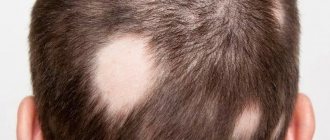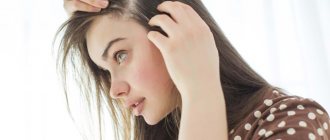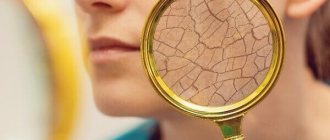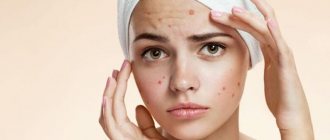Alopecia is hair loss that goes beyond the physiological norm, i.e. Alopecia means increased (not directly related to damage to the hair follicle) or pathological (related to damage to the hair follicle) hair loss.
As you know, in the life cycle of an individual hair there are several stages: growth, transition phase and loss. Under the influence of various factors, the duration of these phases can change, which leads to severe hair loss and baldness. This problem occurs in both men and women, and the success of treatment largely depends on the timeliness of seeking qualified, competent help.
Causes of scalp hair loss
It is known that the tendency to hair loss can be genetically determined (programmed), however, there are a number of other reasons that can contribute to the development of alopecia. Among them are:
- Regular stress;
- Hormone imbalance;
- Childbirth and the postpartum period;
- Unbalanced nutrition and uncontrolled diets;
- Unfavorable environmental situation;
- Mechanical or chemical damage to the scalp;
- Infectious processes.
In addition, hair loss may develop during specific treatment. Alopecia is often observed in patients who have undergone chemotherapy, as well as after long-term use of certain groups of antibiotics, antidepressants, systemic retinoids or other drugs.
Establishing the cause of hair loss is one of the most important tasks for a trichologist, since further treatment and its effectiveness will depend on this.
Common manifestations of alopecia areata
Signs of pathology appear at the age of 15-25 years. Alopecia areata can develop quickly and suddenly. At the first stage, the hair shafts become thinner, then small areas of hair loss form. Over time they begin to grow.
Men more often suffer from alopecia areata, but this unpleasant problem also affects women. The disease usually affects people with naturally dark hair color.
The hairs growing near the affected area become fragile, painlessly, and easily pulled out. Under a microscope, the shaft of such a hair narrows towards the base, and together with the dead root, it becomes like an exclamation mark. This type of hair is a clear sign of alopecia areata.
Most often, alopecia appears on the scalp. As long as there is a single small area of baldness, it can be covered under hair for a while, but this is unlikely to relieve constant discomfort. When there are more outbreaks, and even more so when they begin to merge into one, it is very difficult to manage without the help of a good specialist.
Features of focal baldness in women
In women, alopecia areata is less common than in men, but it brings almost more problems. Of course, with a long hairstyle it is much easier to hide a small “bald spot”, but with numerous lesions this will be very difficult to do. Alopecia areata is treatable, and if you consult a specialist in a timely manner, it can go away quite painlessly.
To look attractive, women are accustomed to changing their hair color, using curling irons, hairsprays, mousses, hair dryers, straighteners, and also resorting to methods such as perm and lamination. Therefore, a common cause of baldness in women is disruption of the natural hair structure. To prevent pathology, experts advise trying to reduce the negative impact on hair.
Features of focal baldness in men
The first symptom of focal baldness in men is the appearance of a small “bald spot” on the top of the head. It is gradually growing and increasing in size. The disease can affect facial hair, giving the beard a patchy appearance. Thanks to shorter hairstyles, it is easier for men to notice changes in the scalp and immediately seek advice from a trichologist.
Types and types of alopecia
Depending on the mechanism of hair growth disorder, there are two main types of alopecia: non-scarring and cicatricial. In this case, the first type can transform into the second, in the absence of proper and timely treatment.
- Non-scarring alopecia is the most common and can be either diffuse or focal. This type of hair loss develops for reasons that are not related to scar damage to the hair follicle.
- Cicatricial alopecia is characterized by scar deformation and destruction of hair follicles due to inflammation, injury or other causes. This is the most unfavorable type of hair loss in terms of prognosis.
The cause of cicatricial alopecia can be infections (viral, bacterial, fungal), physical trauma, thermal or chemical burns, causing severe inflammatory reactions, in the place of which connective tissue is formed, as well as in certain types of skin diseases (discoid lupus erythematosus, Broca's pseudopelade ).
Types (forms) of hair loss
Both scarring and non-scarring types of alopecia are divided into types (or forms).
The most common forms of hair loss, which affect both men and women, are:
- Androgenetic alopecia;
- Diffuse (telogen effluvium) alopecia;
- Alopecia areata or focal alopecia.
What is androgenetic alopecia
Androgenetic alopecia is the most common form of hair loss in both sexes.
- In men, the process of baldness most often begins in adolescence and goes through several stages: first, there are bilateral bald patches above the forehead, then a bald spot appears, which gradually expands from the forehead to the crown of the head, and in the end only a narrow strip of hair remains on the temples and the back of the head.
- In women, this type of baldness progresses more slowly and usually results in diffuse hair thinning, which is also more pronounced in the frontoparietal region.
Causes of androgenetic alopecia
The development of androgenetic alopecia at the present stage is associated with:
- Firstly, with an increase in the activity of the enzyme 5-alpha reductase in the tissues of the hair follicle, which converts the inactive form of the male hormone testosterone into its more aggressive form, dihydrotestosterone (DHT). As a result of this activity of the enzyme 5-alpha reductase, the concentration of DHT increases around the cells of the hair follicle, which causes a damaging effect, causing atrophy of hair follicles in androgen-dependent zones (usually the frontoparietal zone).
- Secondly, the increased sensitivity of the hair follicle cell receptors themselves to the normal level of DHT in the androgen-dependent areas of the scalp
- Thirdly, androgenetic alopecia occurs in people with a hereditary predisposition, for this purpose genetic testing is carried out to determine risk factors for baldness.
Androgenetic alopecia develops in stages and is assessed using the Norwood scale (for men) and the Ludwig scale (for women).
Norwood scale
Ludwig scale
Diagnosis of androgenetic alopecia
The diagnosis of androgenetic alopecia is established on the basis of: patient complaints, local examination, assessment of data obtained during trichoscopy and phototrichogram, blood test results obtained during the study of hormonal status, as well as additional research methods in identifying hormonal disorders.
Treatment of androgenetic alopecia
The basic principles of treatment of androgenetic alopecia are the use of antiandrogenic drugs externally and internally, and symptomatic treatment of damage to the hair follicle that was established during trichoscopy and phototrichogram (physiotherapy, hair mesotherapy, laser treatment, plasma therapy, etc.)
What is diffuse alopecia
Diffuse (telogen effluvium) alopecia is manifested by uniform active hair loss over the entire surface of the head in people of both sexes and develops under the influence of a stress factor and with an improper, unbalanced diet. In such cases, metabolic processes in the cells of the hair follicle are disrupted, which leads to a shortening of the growth phase and damage to the hair shaft. Diffuse alopecia never ends with the development of fibrosis and is the most treatable.
Diagnosis and treatment of diffuse alopecia
Diagnosis of the diffuse form of alopecia is based on trichoscopy and phototrichogram. With a correct diagnosis, elimination of the factors leading to the development of alopecia and with well-chosen treatment, complete restoration of hair growth can be achieved.
In the pathogenetic treatment of diffuse alopecia, drugs and methods are used that improve metabolic processes in the hair follicle.
What is alopecia areata
Alopecia areata (focal) is a consequence of autoimmune processes in which hair follicles are selectively affected. With this form of alopecia, there is the formation of lesions in which hair does not grow. These lesions can have different shapes and sizes, can merge with each other, and be located in different parts of the head and torso. The exact causes and mechanisms of development of this form of hair loss have not been fully established. Due to autoimmune damage to the follicles, hair quickly moves from the growth phase to the transition phase and the shedding phase.
Diagnosis and treatment of alopecia areata
The diagnosis is established based on the identification of typical foci of baldness, local and general examination, and data obtained during trichoscopy. Sometimes it happens that untreated alopecia areata develops into a universal form (hair loss over the entire skin), which is less treatable. The main pathogenetic method of treatment is the elimination of inflammation in the lesion, the use of drugs that reduce the activity of autoimmune aggression, followed by stimulating treatment.
In our clinic, in order to establish the type and type of alopecia, the trichologist prescribes a comprehensive examination, which includes taking an anamnesis, a general examination of the patient, clinical and instrumental examination, and necessarily trichoscopy and phototrichogram and other types of diagnostics.
Laser physiotherapy at home
If you are desperate and ask for “help stop hair loss,” we can advise you to use a unique comb, which has lasers in its design.
The Hairmax Lasercomb device is optimally suited to stop severe hair loss, what should you do with a comb?
It is necessary to comb your hair regularly using the device. It is equipped with nine lasers, which, when exposed simultaneously, lead to intense hair strengthening. Laser comb is suitable for men, women. It specifically affects weak follicles and increases cell performance. As a result of laser exposure, the following occurs:
- activation of blood supply to tissues;
- the volume of nutrients supplied to the bulbs increases;
- the removal of toxins is accelerated.
This is an effective remedy against hair loss, as confirmed by clinical research. For six months, men aged 30-60 used a comb for hair care. In 93% of volunteers who did not know how to stop hair loss by 1 cm², 19 functional follicles appeared due to the awakening of “sleeping” follicles.
A laser comb is the best option for anyone who wants to know how to stop severe hair loss without medications.
Treatment
Once the diagnosis is established, treatment is aimed at eliminating the cause of alopecia and continues until hair growth is restored. Unfortunately, alopecia is quite resistant to treatment, although cases of self-cure have been described.
The doctor must convince the patient that the disease is long-term and it will take quite a long time to achieve the effect. Approaches to the treatment of alopecia are determined by the degree of its severity.
Treatment of alopecia areata with less than 50% hair loss
Corticosteroids are the mainstay of treatment:
- topically (applied to areas of baldness) in the form of creams or ointments - prednisolone, dexamethasone, triamcinolone, fluocinolone, etc.);
- intradermal injections into areas of baldness;
- Retin A preparations, preferably in the form of ointment or gel forms;
- Minoxidil, a drug used to treat arterial hypertension, has shown a fairly good effect for the treatment of alopecia. Its effectiveness is higher when combined with Retin A. With this combination, minoxidil is applied to bald areas in the morning, and retin is applied in the evening.
- zinc for oral administration has an immunomodulatory and antiandrogenic effect. But to achieve a therapeutic effect, fairly high doses will be required, and this, as a rule, leads to the development of side effects: nausea, vomiting, diarrhea.
- tar-like ointments (Ditranol), used in the treatment of psoriasis, are also suitable for topical use for alopecia.
- vitamin therapy - especially B vitamins (B1, B6, B12).
Treatment of alopecia areata with loss of more than 50% of hair
- Corticosteroids for systemic use (orally, injectable forms). Only the doctor controls the dose and duration.
- PUVA therapy: the patient takes a photosensitive substance, followed by ultraviolet irradiation. The procedure is carried out 2-3 times a week for 3 – 6 weeks.
- Irritating substances or allergens - topically on areas of baldness.
- Immunosuppressants (cytostatics) - in severe cases to suppress the autoimmune reaction.
Treatment of androgenetic alopecia includes the use of oral contraceptives for women; for men, a drug has been developed that suppresses the activity of 5-alpha reductase - Propecia. The drug is used once a day for 3 months.
Drugs used in other industries also have an antiandrogenic effect: spironolactone (veroshpiron) is a diuretic drug; cimetidine – reduces the acidity of gastric juice; ketoconazole (Nizoral) – intended to treat fungal infections; preparations based on polyunsaturated fatty acids.
Causes of pathology
Alopecia areata is a pathology, the exact causes of which are still not clear. It has been determined that the disease is usually autoimmune in nature. This means that the patient’s body begins to perceive hair follicles as foreign formations and simply rejects them.
The reasons for this process of baldness include:
- Hereditary factor.
- Hormonal imbalance.
- Various diseases: frequent acute respiratory viral infections and other viral infections, pathologies of the gastrointestinal tract, infectious diseases, atopic dermatitis, etc.
- Stress factors.
Often, focal pathology occurs in the presence of several provoking factors. For this reason, treatment is never carried out according to ready-made schemes, but requires an individual approach.
Benefits of therapy at An-Tech Labs
- Experienced doctors. Our trichologists have been providing treatment for focal forms of pathology for several years and are fighting baldness of their patients using the most modern means. Doctors have all the necessary knowledge and skills for truly effective therapy.
- Integrated and individual approach. Treatment always includes several remedies and procedures for focal pathology, which allows achieving pronounced results of therapy in the shortest possible time.
- Optimal cost for all services. Treatment of even advanced focal forms of pathology is available to patients with a limited budget.
- No queues due to a sufficient number of doctors.
Contact us!
We are ready to advise you and prescribe the necessary therapy after a comprehensive diagnosis. Back to list of services











